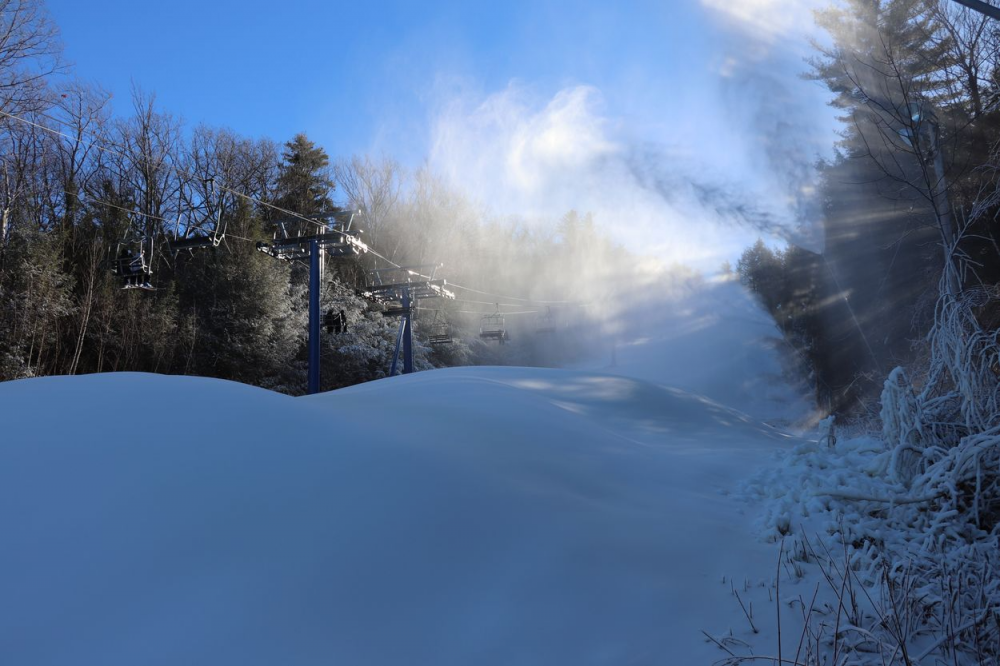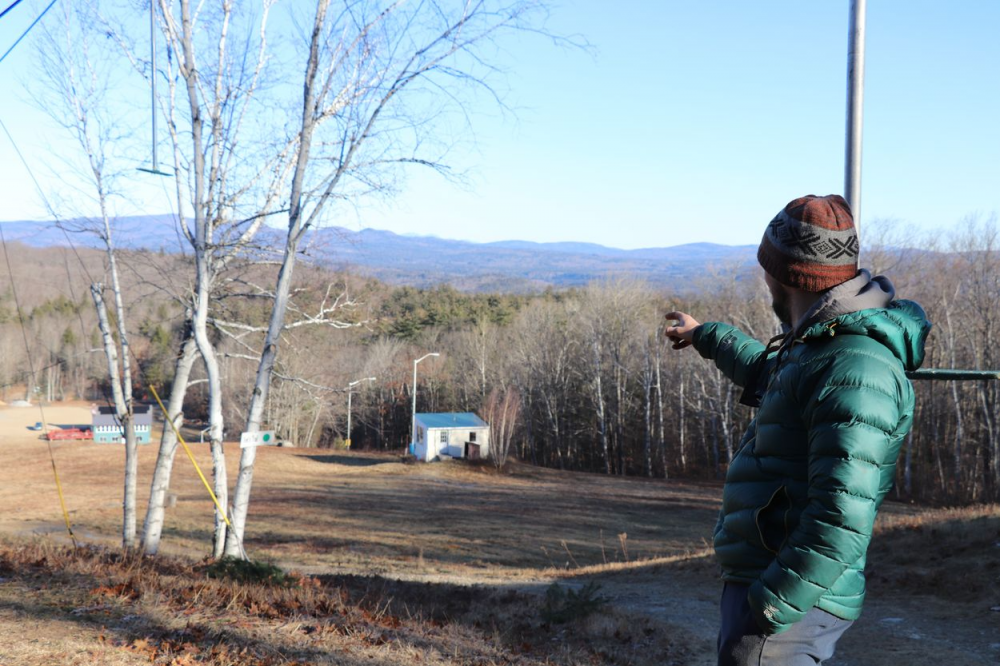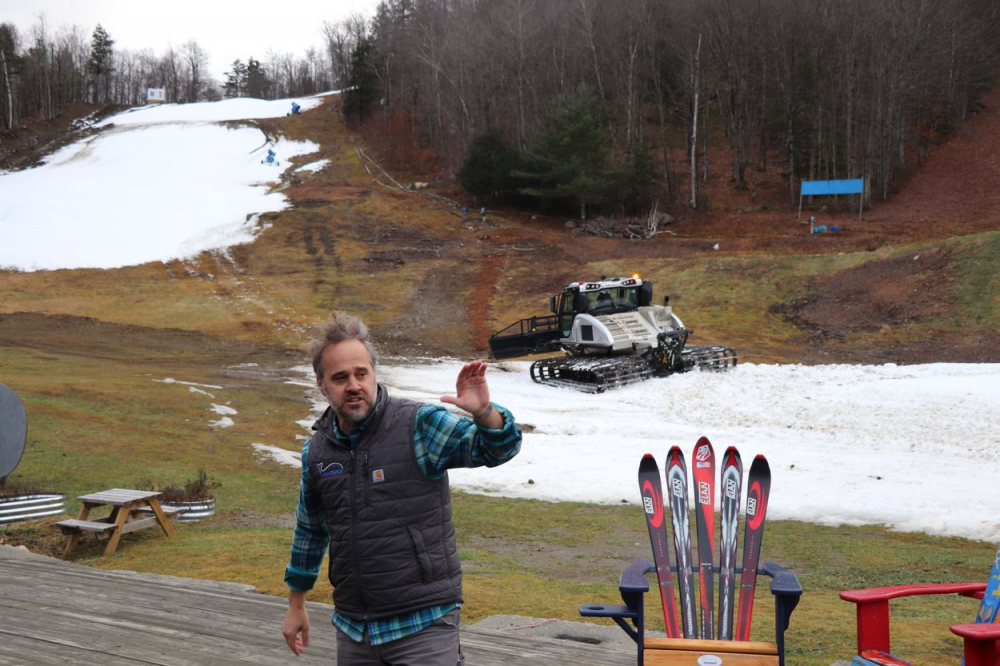This is the second article in a series on New Hampshire skiing in the age of climate change. You can find the introduction here.

Snowmaking on the Downdraft trail at Pats Peak just days after the December 18th rainstorm. (Photo: Beatrice Burack)
Late last December, just before Christmas and only four days after historic floods ripped across New Hampshire, Pats Peak Ski Area in Henniker was a veritable winter wonderland—with a packed parking lot. That was no thanks to Mother Nature. Instead, General Manager Kris Blomback could point to his 12-member snowmaking staff, $5 million snowmaking system, and 610 snow guns.
“We got our face kicked in for 24 hours, and then we came right back and within 48 hours it was a distant memory,” Blomback said, referring to the December 18th storm.
Steve Tanner, a Massachusetts resident who’d brought his three and seven-year-olds skiing at Pats Peak for the day, was surprised to see so much snow on the trails. “I didn’t even bring my stuff this time because I didn’t think there would be this much open [...] I just assumed we’re just gonna do the magic carpets. In hindsight,” he said, “I should’ve brought my stuff.”
But if Tanner had driven another 50 minutes northeast to Veterans Memorial Recreation Area in Franklin or northwest to Whaleback Mountain in Enfield that same week, he’d have found slopes nowhere near ready for skiers.
The Vets, Franklin, New Hampshire
On December 21st, Tim Morrill’s white Chevy Silverado struggled through deep ruts left by the storm, as he made his way to the top of Veterans Memorial in Franklin. There, he walked along trails he’s skied since childhood, naming them as he went: Wilderness, Drake’s Drop, Race Trail. The White Mountains stood in the distance, fading from green, to purple, to blue. Two bright yellow snow guns, bought second-hand from the exclusive Yellowstone Club in Montana, shone incandescent at the bottom of the hill. Nowhere on the grassy hill was a speck of snow to be found.
Morrill is the president of the Franklin Outing Club, which operates the non-profit Veterans Memorial ski hill (called ‘The Vets’ by locals). The Vets offers 230 vertical feet of skiing and is one of a few remaining community ski hills in the state. Its $15 adult nighttime tickets and frequent free ski days are almost unheard of in an industry dominated by the $1,000 dollar Epic and Ikon passes. The Vets gets by with help from donations, an all-volunteer maintenance and patrol crew, and local business sponsorships.
Morrill and his brother are the third generation in their family to be involved at the hill. “I’ve been up here my whole life,” he said. “My grandfather was one of the original members and my folks were involved, so I’ve been here, I love it, and we’re trying to stay focused and keep it going with the changes in the world.”

Franklin Outing Club President Timothy Morrill stands next to The Vets’ 1940s-era T-bar, pointing out mountains in the distance. Morrill has been skiing at The Vets since his childhood. (Photo: Beatrice Burack)
These changes, including warming winters, are hitting small community ski hills like The Vets hard. It’s not unusual for The Vets to be closed for the first couple months of “winter”. Until now, they have relied only on natural snow, meaning they’re usually only open for the months of February and March, Morrill said. With snowmaking, he hopes they’ll be able to move opening day to January some years. But this season, he bided his time.
The Vets bought their new snow guns with funding from the Merrimack County Board of Commissioners earlier in 2023, but as of late December, Morrill had yet to fire them up for the season.
“We’re watching the weather. We’re going to see what happens [...] next week. We don’t want to spend all this money and then lose it,” he explained. “We would’ve lost it all last week.”
The Vets, with an operating budget of about $40,000 dollars a year, can’t afford to rack up a high energy bill making snow just to see the new white gold wash away a few days later.
Morrill says he’d like eventually to be able to make snow on the whole mountain, but that would have to happen in stages, with more grant funding. Asked if he’s considered raising ticket prices to pay for operations, Morrill says that’s not in his plans: “We’re trying to stay as low [on ticket prices] as we can.”
As Morrill sees it, The Vets’ chief value is in making skiing more affordable: “The biggest thing I see at this mountain is families coming, people coming that could not [otherwise] afford it. And we do a donation room so there’s free gear. If you become a member, you can come grab gear, go get it tuned up, and then you can ski. And in a world where skis are not cheap, the equipment is not cheap, that helps out a lot.”
The sense of community The Vets adds to Franklin, he adds, is also key. “I think having this place keeps us part of that small-city community still in our area [...] everybody knows everybody, everybody’s friendly, everybody helps everyone out.”
As for the future, even with snow guns, Morrill is worried. “Climate change, that makes me nervous,” he says. “We’re trying to find other ways to still be a recreation area. We might not always be a ski area. We might have to change. But we want to be a ski area as long as possible.”
Whaleback, Enfield, New Hampshire
The day after the big floods, there was still some snow clinging to the sides of Whaleback Mountain. But Executive Director Jon Hunt, looking out at the mountain from his office in the base lodge, knew it wouldn’t be enough.
Hunt wanted the mountain fully open by December 26th. Due to the rains, that goal shifted to opening just the magic carpet and rope tow areas for the week after Christmas.
Hunt aims to be open 100 days each season, starting on the 26th. “If you can get to 100 days, we feel like that’s a good long season,” he said back in December. “We haven’t hit it in years.” For the past few seasons, Whaleback has hovered around 70 to 80 open days.
But the mountain is finding ways to adapt to warmer temperatures and less snowfall.

Whaleback Mountain Executive Director Jon Hunt discusses Whaleback Mountain’s snowmaking operations while a machine moves snow in the background. (Photo: Beatrice Burack)
They’re working to install a new chairlift to complement their existing 1970s two-seater Poma lift. The new chair will go only partway up the mountain, allowing Whaleback to open its race trail for skiing and race training before they’re able to cover the whole mountain with snow.
Last year, Whaleback also received a grant from the USDA and the Northern Border Regional Alliance, which will allow them to purchase nine snow guns and another water pump, effectively doubling their snowmaking capacity.
For Whaleback, the struggle to adapt and stay open is nothing new. The mountain, founded in 1955 under the name Snowcrest, went bankrupt in 2012. It was salvaged by the formation of the Upper Valley Snowsports Foundation, a 501(c)(3) nonprofit that has owned and operated the mountain ever since.
Hunt says the role of community mountains like Whaleback is to provide an arena for beginners to get acquainted with skiing and snowboarding. He thinks many of his customers also hold passes at larger mountains, but keep coming back to Whaleback due to its convenient location, short lift lines, and opportunities for skiing after work on weeknights.
“You bring your children here, they learn how to ski or ride here, they start to develop, they grow, and eventually they go to a bigger mountain. And then someday, they bring their children back here and the cycle continues,” Hunt explains.
He stresses the need for cooperation between smaller mountains like Whaleback and larger mountains in the region. “[T]he partnership between bigger mountains and smaller mountains needs to be really tight, because we both need each other, because we help develop skiers.”
But while he sees those larger mountains facing the same major challenges he does, they seem better prepared to address it. “We’re all battling warmer climate, we’re all battling three inches of rain on December 18th. I think where it’s different is we’re just working with less resources. We have to be more thoughtful and efficient than some of the other areas in that when we make snow, the conditions have to be perfect,” he says.
As December’s storm demonstrated, many hours of snowmaking can go to waste if the weather doesn’t stay cold afterwards. Whereas mountains with larger operating budgets are able to swallow some of that risk or build up enough snow to survive a few days of warmer conditions, places like Whaleback and The Vets don’t have that luxury.
As the season got going, Hunt laid out some numbers to show what a warm December means for his mountain. “Last year, 2022-23, as of December 31st, we had made snow for 192 hours. This year, as of today [December 19th], we’ve made snow for 84 hours. So that’s roughly 108 less hours of available snowmaking weather that we’ve had this year. It’s been that much warmer.”
Shorter snowmaking periods make it all the more important to have efficient snowmaking equipment—and the funds to run it.
Pat’s Peak, Henniker, New Hampshire
At Pats Peak, a dozen or so snow guns covered the Downdraft trail with rolling hills of white powder in just twelve hours a few days after the storm. Blomback, the general manager, held some of the fresh snow in his hand, squeezing it to show its consistency. “See how wet it is? That’ll all cure overnight.”
Blomback’s 40 years as a snowmaker and mountain manager have made him highly attuned to the ways of air, water, and their byproduct, snow.
He explained that each snow gun is fed by two large pipes, one carrying compressed air, and one with water. “You hook a gun up to [the pipes] and you bring them together inside. The water molecule comes up inside that snow gun and then gets smashed by the compressed air into a million little pieces.”
“The process is simple, but the system is complex,” he said.
The air and water pipes at Pats Peak are connected to massive, powerful pumps in a large, nondescript building by the base of the beginner area chairlift. In all, 26 miles of such piping snake across 120 acres of skiable terrain, with hydrants every 100 feet that can be connected to snow guns.
As Blomback criss-crossed Downdraft, he turned the guns off one by one, letting their loud hissing noises slowly fade to whispers. He left the heaping white mounds of new snow to cure for 24 to 36 hours before the groomers would come in to smooth them out into a flat, skiable surface.
He walked to the base of the magic carpet, where first-time skiers were making their way down the area’s slight incline in fits, starts, and (often) falls. Blomback’s dark glasses blocked the warm mid-afternoon rays as he gazed up at the customers enjoying his handiwork.
“Pats would not be able to survive without snowmaking,” he said. “I would say it’s just always been difficult in southern New Hampshire. I affectionately call this area the banana belt. [...] You’re not the White Mountains. You’re not the Green Mountains. You’re the foothills.”
In some senses, Blomback explained, Pats Peak was ahead of the curve. When the area opened in the ‘60s, the owners immediately saw the need for snowmaking. “Their first year they were like, ‘Ah, there’s no snow. We can’t open.’ So they quickly realized they had to make an investment in snowmaking to be viable,” he said.
Sixty years later, Blomback thinks that advances in snowmaking technology will allow the mountain to continue to stay abreast of warming winters.
“We will always make the investments into our ability to make snow so that if that window [of time with cold temperatures for snowmaking] keeps shrinking, we just keep doing the math, and we beef up our pumping capacity or we beef up our pipelines or we beef up how much water we can deliver.”
He also stressed that what he calls “the bookends of the season”—the days between November 15th and December 15th, and March 15th to April 15th that often see lower snowfalls—are not as important to the mountain’s bottom line. “So long as you have a decent showing for Christmas week,” he said, “we’ll be in good shape.”
Different Futures
610 snow guns and ample snow on the slopes in time for Christmas week are good reasons for Blomback to be sanguine about his mountain’s future. But for mountains that cannot afford to make those investments, the future looks less certain.
“[I]t is not the entire ski market that is necessarily at risk to climate change, but rather at risk are individual ski areas and regions that are not able to adapt to or afford the increased costs of adapting to projected change.” That’s the message from a 2013 study on the impact of climate change on 103 ski areas in the Northeast.
That message was on full display when warm weather forced The Vets to close last weekend, after just under a month-long season, and caused Whaleback to shut down its chairlift as March got under way, leaving only its beginner area open to skiers, with a planned closure for the season on March 10. Pats Peak, meanwhile, had 22 trails open as of March 6th.
The threats to small New Hampshire ski areas are also evident to perusers of Jeremy Davis’ New England Lost Ski Areas Project website, which lists 172 New Hampshire ski areas that have shut down over the years. Davis, a meteorologist by training who has been studying lost ski areas ever since he came upon abandoned Mount Whittier in the early 90s, says that he can’t point to just one factor that caused these areas to shut down. Among the factors he’s identified, however, are changing technology and variable weather.
“The technology keeps getting better and better, but [for] these smaller places, it becomes more and more unaffordable [...] a lot of them couldn't quite compete and ended up closing, or the weather was so challenging at certain times that that led to their closing as well,” he says.
Jessyca Keeler, president of industry trade group Ski New Hampshire, emphasizes that while smaller ski areas tend to have less available capital than their larger counterparts, ski areas of both sizes are vital to the health of the industry.
“We think that by helping those smaller ski areas be more successful, ultimately, they’re going to be feeder [...] ski areas, where they’re kind of nurturing newer, younger skiers or families [...] and then maybe some of those folks will move on to ski at some of the bigger ski areas and just become lifelong skiers that ultimately help support the industry,” Keeler says.
Keeler also points to the affordability of smaller ski hills as a welcome balance in a world of higher lift ticket prices: “Skiing can be expensive [...] So, to have those options for people to ski more often at those small ski areas where it’s significantly more affordable, it’s great.”
Davis recommends skiing smaller areas like Veterans Memorial for a different reason.
“They’re living museums in a way,” he argues. “You go to that Veterans Memorial, you’ll feel exactly the way it was skiing 50 years ago. The lodge, the outside, everything looks the same,” he says. “You actually really felt like they welcomed you when you went in there, they wanted you to ski. The lift operators would ask how your day was going, you know?”
Davis notes one update, though: “Even they’ve invested in a little snowmaking system.”
Beatrice Burack is a Granite State native and a junior at Dartmouth College working as a freelance journalist in the Upper Valley. Her work has appeared in the New Hampshire Bulletin*, NHPR,* NH Business Review*, and the* Valley News*, among other publications. She can be reached at bea.c.burack.25@dartmouth.edu. Her exhibit on NH skiing in the age of climate change opens in Reiss Hall in Dartmouth’s Baker Library on Monday, March 11th. It will stay up through May.
These stories were first published in Daybreak, an email newsletter focused on the Upper Valley, New Hampshire, and Vermont, and are being shared with the partners in The Granite State News Collaborative.

 Current Issue - July 2024
Current Issue - July 2024